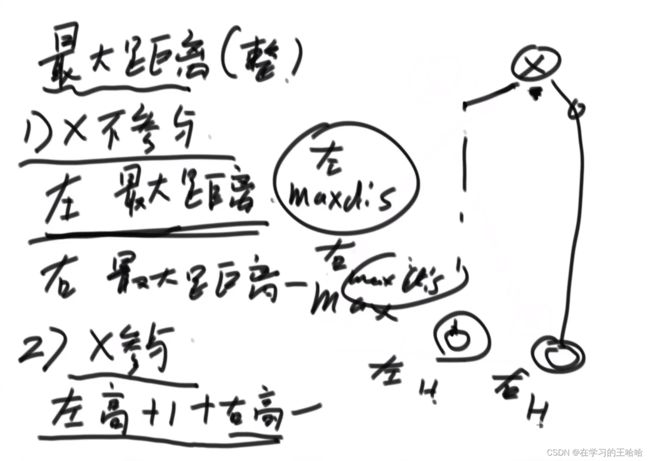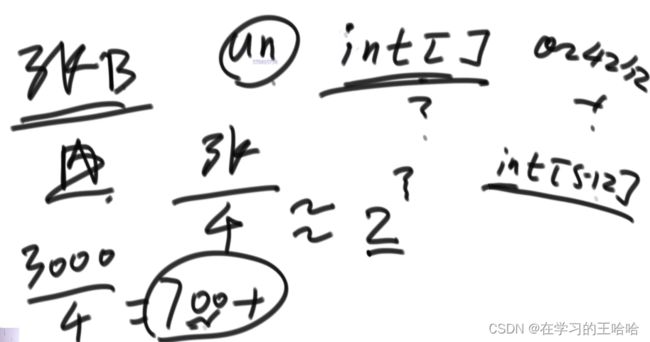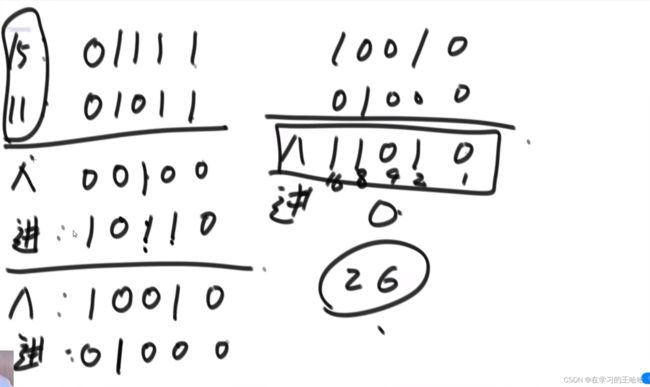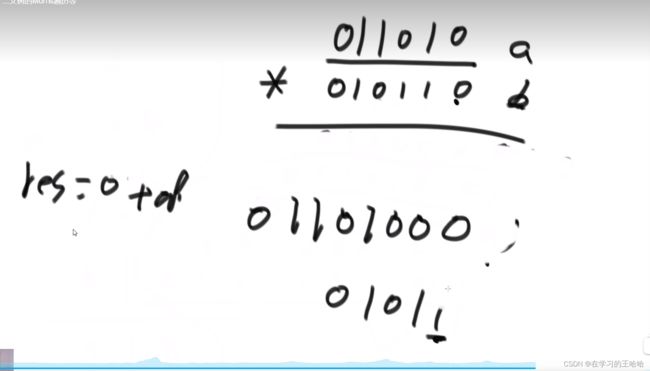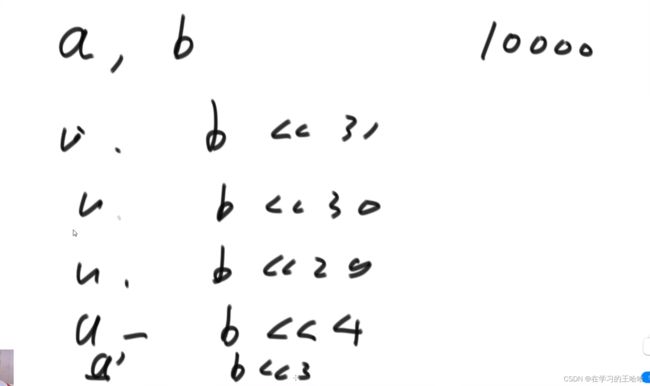数据结构与算法笔记六(树形dp,Morris遍历,大数据相关题目,位运算 )
数据结构与算法笔记
- 树形dp
-
- 二叉树节点间的最大距离问题
- 排队的最大快乐值
- Morris遍历
-
- morris判断是否是搜索二叉树
- 二叉树的递归套路和Morris如何选择?
- 大数据相关题目解题技巧
-
- 利用分段统计的思想、并进一步节省大量空间
- 找出重复URL
- 找出所有出现了两次的数
- 10G文件,5G内存
- 位运算的题目
-
- 给定两个有符号32位整数a和b,返回a和b中较大的。
- 判断一个32位正数是不是2的幂、4的幂
- 无符号实现加减乘除
树形dp
二叉树节点间的最大距离问题
leetcode543

可以分为头节点参与的和头节点不参与的,
头节点不参与:不经过头节点的。左树的最大距离,右数的最大距离。
头节点参与的:最大距离可能经过 头节点,左树最远的点到右树最远的点。 左高+1+右高
三者之间取最大值
排队的最大快乐值

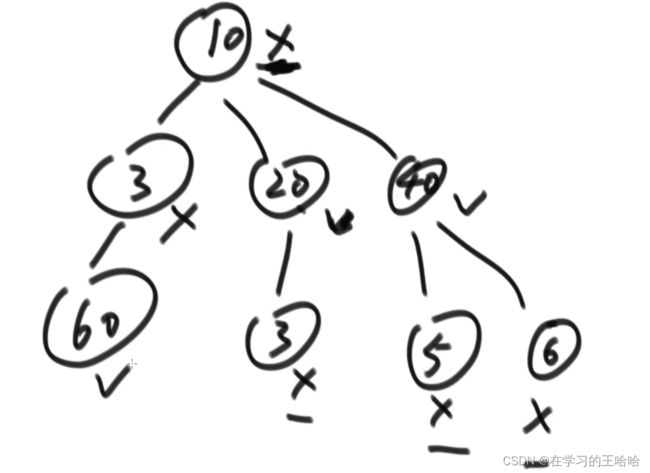
以x为头的整棵树快乐值是多少
x参与:x乐 + a的整棵树在a不来的情况下的最大快乐值 + 在b不来的情况下的最大快乐值 + 在c不来的情况下的最大快乐值
x不参与:0 + Max(a的整棵树在a来的情况下的最大快乐值,在a不来的情况下的最大快乐值 )+max(b) + max(c )
package com.wanghaha.algorithm;
import java.util.List;
public class Day7_15_51MaxHappy {
public static class Employee{
public int happy;
public List<Employee> nexts;
}
public static int maxHappy(Employee boss){
Info headInfo = process(boss);
return Math.max(headInfo.buMaxHappy, headInfo.laiMaxHappy);
}
public static class Info{
public int laiMaxHappy;
public int buMaxHappy;
public Info(int laiMaxHappy, int buMaxHappy){
this.buMaxHappy = buMaxHappy;
this.laiMaxHappy = laiMaxHappy;
}
}
public static Info process(Employee x){
if(x.nexts.isEmpty()){ // x是基层员工的时候
return new Info(x.happy, 0);
}
int lai = x.happy;
int bu = 0;
for (Employee next : x.nexts) {
Info nextInfo = process(next);
lai += nextInfo.buMaxHappy;
bu += Math.max(nextInfo.laiMaxHappy,nextInfo.buMaxHappy );
}
return new Info(lai,bu);
}
}
Morris遍历


当前节点如果有左树,一定会回到两次

每次都要遍历找到cur的左子树的右边界 时间复杂度不会上升
所有右边界都是不重复的

public static void morris(Node head){
if(head == null){
return;
}
Node cur = head;
Node mostRight = null;
while (cur != null) {
mostRight = cur.left; // mostRight 是 cur的左孩子
if( mostRight != null){
while (mostRight.right != null && mostRight.right != cur){
mostRight = mostRight.right;
}
// mostRight 变成了cur的左子树上 最右的节点
if(mostRight.right == null){
mostRight.right = cur;
cur = cur.left;
continue;
}else { // mostRight.right == cur
mostRight.right = null;
}
}
cur = cur.right;
}
}
先序: 如果一个节点只到达一次,直接打印。如果一个节点到达两次,第一次打印

public static void morrisPre(Node head){
if(head == null){
return;
}
Node cur = head;
Node mostRight = null;
while (cur != null) {
mostRight = cur.left; // mostRight 是 cur的左孩子
if( mostRight != null){
while (mostRight.right != null && mostRight.right != cur){
mostRight = mostRight.right;
}
// mostRight 变成了cur的左子树上 最右的节点
if(mostRight.right == null){ // 第一次来到cur
System.out.print( cur.value + " ");
mostRight.right = cur;
cur = cur.left;
continue;
}else { // mostRight.right == cur
mostRight.right = null;
}
}else {
System.out.print( cur.value + " ");
}
cur = cur.right;
}
}
中序:只有一次的节点,直接打印。 有两次的节点,第二次打印。

public static void morrisIn(Node head){
if(head == null){
return;
}
Node cur = head;
Node mostRight = null;
while (cur != null) {
mostRight = cur.left; // mostRight 是 cur的左孩子
if( mostRight != null){
while (mostRight.right != null && mostRight.right != cur){
mostRight = mostRight.right;
}
// mostRight 变成了cur的左子树上 最右的节点
if(mostRight.right == null){
mostRight.right = cur;
cur = cur.left;
continue;
}else { // mostRight.right == cur
mostRight.right = null;
}
}
System.out.print(cur.value + " ");
cur = cur.right;
}
}
后序:把打印时机只放在能回到两次的节点。遇到第二次出现的节点,逆序打印自己左树的右边界。完了之后单独打印整棵树的右边界(逆序打印)
public static void morrisPos(Node head){
if(head == null){
return;
}
Node cur = head;
Node mostRight = null;
while (cur != null) {
mostRight = cur.left; // mostRight 是 cur的左孩子
if( mostRight != null){
while (mostRight.right != null && mostRight.right != cur){
mostRight = mostRight.right;
}
// mostRight 变成了cur的左子树上 最右的节点
if(mostRight.right == null){
mostRight.right = cur;
cur = cur.left;
continue;
}else { // mostRight.right == cur
mostRight.right = null;
printEdge(cur.left);
}
}
cur = cur.right;
}
printEdge(head);
System.out.println();
}
//以X为头的树,逆序打印这棵树的右边界
private static void printEdge(Node head) {
Node tail = reverseEdge(head);
Node cur = tail;
while (cur != null) {
System.out.print(cur.value + " ");
cur = cur.right;
}
reverseEdge(tail);
}
public static Node reverseEdge(Node from) {
Node pre = null;
Node next = null;
while (from != null) {
next = from.right;
from.right = pre;
pre = from;
from = next;
}
return pre;
}
morris判断是否是搜索二叉树
package com.wanghaha.algorithm;
public class Day7_20_IsBSTwithMorris {
public static boolean morris(Node head){
if(head == null){
return true;
}
Node cur = head;
Node mostRight = null;
int preValue = Integer.MIN_VALUE;
while (cur != null) {
mostRight = cur.left; // mostRight 是 cur的左孩子
if( mostRight != null){
while (mostRight.right != null && mostRight.right != cur){
mostRight = mostRight.right;
}
// mostRight 变成了cur的左子树上 最右的节点
if(mostRight.right == null){
mostRight.right = cur;
cur = cur.left;
continue;
}else { // mostRight.right == cur
mostRight.right = null;
}
}
if(cur.value <= preValue){
return false;
}
preValue = cur.value;
cur = cur.right;
}
return true;
}
}
二叉树的递归套路和Morris如何选择?
如果必须做第三次信息的强整合,就是要想左树要信息,向右树要信息,然后在进行判断
如果需要遍历,依次判断,那么morris是最优解。
大数据相关题目解题技巧
利用分段统计的思想、并进一步节省大量空间
如果只给3kb的空间呢,找到一个未出现的数
申请一个长度为512的整形数组,把0~ 2 32 − 1 2^{32}-1 232−1这个范围分为512份,然后将40亿个数分别除以8388608,在512的那个范围上,就将该数+1,当计算完了后,一定会用某一范围的词频不够8388608个,然后 对这一范围的再分为512份,进行词频累加。
周而复始。就会找出哪一个没有出现的数

找出重复URL
二维堆结构
补充问题解法:先进行分区,然后在小文件中使用哈希表,算出小文件中的top100,如何合并?使用堆
将所有小文件中的top100进行大根堆排序,然后将所有大根堆的堆顶拿出来,单独组成一个大根堆,称为总堆。弹出堆顶 就是全局最大的。 然后看弹出的堆顶是来自哪一个大根堆?然后将该大根堆的第二多的数 弹出到总堆里。
总堆就是将各个大根堆的最大的元素进行pk
找出所有出现了两次的数

不能使用哈希表,一个数4字节,词频 四字节,也就是一条记录8字节。 40亿个数会爆掉的
可以使用哈希分流然后在小文件中使用哈希表,然后再进行汇总。
也可以使用位图,位图可以表示一个数出现过,或者没有出现过。可以用两个位信息来代表该数的状态,00,01,10,11.
数的范围是0~ 2 32 − 1 2^{32}-1 232−1,如果想统计这个范围上所有i的数字,每个数用两个bit来表示它,则需要 ( 2 32 − 1 ) ∗ 2 (2^{32}-1) * 2 (232−1)∗2个bit, 所有需用 ( 2 32 − 1 ) ∗ 2 / 8 (2^{32}-1) * 2/8 (232−1)∗2/8byte字节,
补充问题:词频统计
10G文件,5G内存
10G的文件,每一个文件是一个有符号整数,无序的,如果只给你5G的内存,输出一个有序的10g文件。

堆的技巧

方法一: 整数+词频统计共占8字节,还有一些额外的内存消耗,就按16字节算, 2 4 2^4 24,5G内存空间也就是 5 ∗ 2 30 5 * 2^{30} 5∗230byte,能存储 n = 2 27 2^{27} 227个整数,然后将整数范围 − 2 31 到 2 31 -2^{31} 到2^{31} −231到231按n进行分区,共分为了 2 5 2^5 25区,然后根据第一个分区对整个文件进行遍历,如果是该分区的数,就记录在小根堆中并且词频+1。周而复始。最后就有了从 − 2 31 到 2 31 -2^{31} 到2^{31} −231到231词频的数,然后将他们依次乘以词频放入在
方法二: 用大根堆存 用来存所有的数字中最小的n个数,此时y值等于小的数 ,输出一个文件后,y值等于输出的数最大的那个, 然后再遍历整个文件,忽略所有比y小的数

位运算的题目
给定两个有符号32位整数a和b,返回a和b中较大的。
判断一个32位正数是不是2的幂、4的幂
4的幂:
第一步:先判断x是否只有一个1
第二步:1只能再0,2,4,8。。。位上, x& 0101010101!= 0 是4的幂
无符号实现加减乘除
异或: 无进位相加
与: 如果要加的话,将产生进位信息
与运算向左移动一位: 就是进位信息
b的相反数: b取反 + 1
>>>高位一定补0(逻辑右移),>>右移负数时高位补的是1(算数右移)

除法
b尽可能的向左移动,不要超过a
a-b不会减出负的


